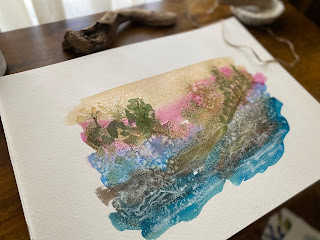How to Paint Coastal Lupines in Watercolor – Depth, Movement & a Little Maine Magic
There’s something magical about lupines blooming along the Maine coast. They’re wild, imperfect, and always moving—like they’re dancing in the wind. Every year when they show up, I feel this quiet pull to paint them.
But painting lupines in watercolor can feel intimidating at first. All those little shapes, overlapping leaves, and shifting colors—it’s easy to overwork them or get caught up in the details. That’s why I wanted to share some helpful tips for capturing them in a way that feels natural, loose, and fun.
You can watch the tutorial for this one on youtube HERE.
 |
| Etsy Shop |
Start with the feeling, not the flower
Instead of focusing on exact shapes, begin by asking: What’s the mood I want to create?
Coastal scenes often have movement—wind in the trees, light in the sky, a breeze rolling over the water. Try to build that into your piece through your brushwork and color transitions. Let the sky blend softly. Keep your trees a bit blurry in the distance. Let the background recede so the flowers can shine.
Work from soft to bold
Lupines look best when they pop against a calm, layered background. I usually start by laying in a light wash for the sky, then adding soft distant trees using wet-on-wet or lifting to create texture and depth. This makes your purples and greens really stand out when you get to the flowers.
Layer your color with purpose
Purples can get muddy fast, especially when mixed with too much green. So take your time layering. Let the first layer dry completely, then build the richness by glazing purples and adding shadows with a bit of Payne’s Gray or Ultramarine Blue.
Tip: Don’t forget to mix some cool and warm greens to create a more natural look—nature rarely sticks to just one shade.
Suggest, don’t overdefine
Lupines have a unique structure, but you don’t need to paint every petal. A few well-placed strokes and suggestions are enough. Leave some white space, break up your shapes, and let your viewer’s eye fill in the rest.
Let go of perfection
This is something I come back to in almost every floral or landscape I paint. The most beautiful pieces often come from looseness, play, and letting watercolor do what it does best: move freely.
When in doubt—use more water, step back often, and trust the process.
Final Thought:
You don’t need to be an expert to capture something beautiful. You just need to show up, stay curious, and be open to surprises along the way. Whether you’re painting Maine’s coastline or your backyard blooms, lupines are a lovely reminder that wild and imperfect can still be absolutely stunning.
Want to go deeper?
If you’d like to see the full, extended version of this painting—along with the real-time process, traceables, and access to my growing library of watercolor tutorials—you’re invited to join me on Patreon. It’s where I share the behind-the-scenes, the messy middle, and the real-time magic of watercolor. I’d love to paint with you there!
💜
Kellie











